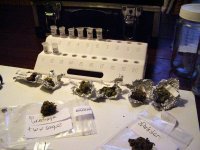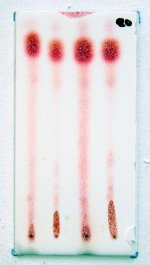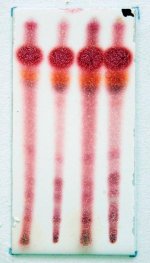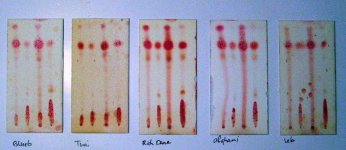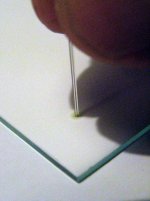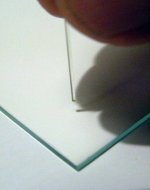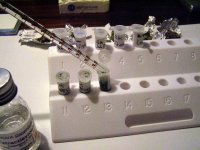You are using an out of date browser. It may not display this or other websites correctly.
You should upgrade or use an alternative browser.
You should upgrade or use an alternative browser.
Are LEDs Misunderstood?
- Thread starter PetFlora
- Start date
These were not cut and pastes from a third source weezard, these are my cannalytics tests. I am a "qualified cannalytics test master", which means I had a 2 day training and several practice sessions to learn the process and make accurate observations. Interpretation of that data is a bit more difficult of course, as the different "cocktails" of cannabinoids have a different effect. I worked closely with Ronald Glas for a few months. On this Dutch forum we did several experiments using the cannalytics test with a few growers and breeders, for example with early leaf material to see if we would be able to predict the final print. The product itself works, and works very easy and accurate if you work clean and precise.
A typical field test.
Putting the drops on the plate
A few results
BHO
Typical thai print
Attachments
dunno,never done led´s but knna seems to be one of the knowledgable people on leds and he says that leds are only good for small grows. (seem kinda expensive for that purpose but hey)
and last time i flew over the greenhouses of amsterdam (last christmas)
i did not see a single telltale purple light, but a shitload of hps´s, visible from high above.
and last time i flew over the greenhouses of amsterdam (last christmas)
i did not see a single telltale purple light, but a shitload of hps´s, visible from high above.
Lacking evidence to the contrary, UV is un-necessary.
Lacking evidence to the contrary, UV is un-necessary.
Very impressive!
You appear to be better at it than the guy in the video.
Alas, it appears also, that my original question;
"I was asking for your actual, personal results comparing UV to non UV grown Cannabis"
Is going to remain un-answered.
<sigh>
Thanks for your time brah.
Now, on with the show.
Green it up PF,
We'll all learn something.
Weeze
Lacking evidence to the contrary, UV is un-necessary.
Very impressive!
You appear to be better at it than the guy in the video.
Alas, it appears also, that my original question;
"I was asking for your actual, personal results comparing UV to non UV grown Cannabis"
Is going to remain un-answered.
<sigh>
Thanks for your time brah.
Now, on with the show.
Green it up PF,
We'll all learn something.
Weeze
my personal observations/results are increased development of trichomes (so more trichomes), earlier development of trichomes, elongated trichome stems, early maturity of trichomes (to cloudy and amber stage) and changes in cannabinoid levels. How exactly UVB influences the cannabinoid levels I do not yet know. I just share my observations from repeated experiments.
knna
Member
Curious thing is I think Whazzup and Weezard mostly agrees with each other, but they look at the topic with different perspectives.
I do mostly agree with Weezard when we talk with the perspective of a small grow for self consumption. In this situation, spaces used are small, usually cold is not an issue, yield requirement may vary from one grow to the next without being a huge problem, and cost may be inexpensive enough compared with other alternatives. In this situation, LEDs works great and I agree complex color mixes are not necessary ( although it dont mean it cant be used to improve results, just that a simple red+blue may work and that blue, white and red definitively works fine).
I only disagree with him about LEDs used. I select LEDs by calculating their efficiency (uE emitted per watt burned) and cost (price per uE emitted). Actually, LedEngines are not good at either of both parameters, although the price may vary depending how and where you source them, of course (so for somebody, LEDEngin may have a better uE/price).
I completely agree Whazzup when I look the topic from a wider perspective. At current prices of LED lighting, in general advantages of the LED lighting not seem enough to compensate the extra cost. It is not that high power LED lamps working as big HID can't be done, but their cost would be too high to be interesting for targeted costumers, so nobody does it. 2-3 years ahead, who knows.
For the moment, only applications for LED lighting in the greenhouse markets are for situations of low light levels (seedlings and in general, very young and small plants), plant species grown for their leafy material (lettuce), and special situations. One application that may spread well is intracanopy lighting (or just, interlighting), as low temperature, solid LEDs are ideal for doing it and many crops benefits of it (included ours)
But I think main problem is price, and not the possibilities of LED lighting for horticulture in general. And the price problem will disappear on a near future.
Light quality is often noted as a drawback of LED lighting for horticulture. I strongly disagree with this. LED lighting allows to tune the spectrum exactly to fit the exact requirements of each situation. Both when close to sunlight spectrum is required or when a very different one offer advantages. But obviously, it requires to know what spectrum is better on each situation, and that knowledge is what we lack. Each plant specie is different, and into each specie, different cultivars (strains) may react different, too.
I devoted most of my research to this topic, as currently there is more that we dont know about than we know for sure.
For cannabis, we are narrowing down the spectrum that works better, at least for whole grows. Except for the UV range, we know decently what we need to use, and how to vary attending to different situations. Now we need to find optimal spectrums for each stage of development and situations as well as "tricks" allowing to affect some traits by lighting manipulation. I think possibilities of LEDs on this are really huge and severely under researched. Blast of light of narrow wavelengths or combinations of narrow wavelengths for short periods of time have the potential of strongly affect outcomes.
Just an example: could strong blue light blasts affect in a similar way than UV? (I suspect so). Either a pair of hours a day, maybe blasts during three days each 15 days, or at the mid of veg period, then after flowering induction and finally at ripening, etc. Possibilities are almost endless. Or, does a blast of very narrow UVB (290 +-5nm, for example) have a different effect or intensity response that wide UVB or UVB+UVA irradiation?
I do mostly agree with Weezard when we talk with the perspective of a small grow for self consumption. In this situation, spaces used are small, usually cold is not an issue, yield requirement may vary from one grow to the next without being a huge problem, and cost may be inexpensive enough compared with other alternatives. In this situation, LEDs works great and I agree complex color mixes are not necessary ( although it dont mean it cant be used to improve results, just that a simple red+blue may work and that blue, white and red definitively works fine).
I only disagree with him about LEDs used. I select LEDs by calculating their efficiency (uE emitted per watt burned) and cost (price per uE emitted). Actually, LedEngines are not good at either of both parameters, although the price may vary depending how and where you source them, of course (so for somebody, LEDEngin may have a better uE/price).
I completely agree Whazzup when I look the topic from a wider perspective. At current prices of LED lighting, in general advantages of the LED lighting not seem enough to compensate the extra cost. It is not that high power LED lamps working as big HID can't be done, but their cost would be too high to be interesting for targeted costumers, so nobody does it. 2-3 years ahead, who knows.
For the moment, only applications for LED lighting in the greenhouse markets are for situations of low light levels (seedlings and in general, very young and small plants), plant species grown for their leafy material (lettuce), and special situations. One application that may spread well is intracanopy lighting (or just, interlighting), as low temperature, solid LEDs are ideal for doing it and many crops benefits of it (included ours)
But I think main problem is price, and not the possibilities of LED lighting for horticulture in general. And the price problem will disappear on a near future.
Light quality is often noted as a drawback of LED lighting for horticulture. I strongly disagree with this. LED lighting allows to tune the spectrum exactly to fit the exact requirements of each situation. Both when close to sunlight spectrum is required or when a very different one offer advantages. But obviously, it requires to know what spectrum is better on each situation, and that knowledge is what we lack. Each plant specie is different, and into each specie, different cultivars (strains) may react different, too.
I devoted most of my research to this topic, as currently there is more that we dont know about than we know for sure.
For cannabis, we are narrowing down the spectrum that works better, at least for whole grows. Except for the UV range, we know decently what we need to use, and how to vary attending to different situations. Now we need to find optimal spectrums for each stage of development and situations as well as "tricks" allowing to affect some traits by lighting manipulation. I think possibilities of LEDs on this are really huge and severely under researched. Blast of light of narrow wavelengths or combinations of narrow wavelengths for short periods of time have the potential of strongly affect outcomes.
Just an example: could strong blue light blasts affect in a similar way than UV? (I suspect so). Either a pair of hours a day, maybe blasts during three days each 15 days, or at the mid of veg period, then after flowering induction and finally at ripening, etc. Possibilities are almost endless. Or, does a blast of very narrow UVB (290 +-5nm, for example) have a different effect or intensity response that wide UVB or UVB+UVA irradiation?
Yay! It's KNNA!
Yay! It's KNNA!
Real happy to see you here, brah.
Your post is so "spot-on I quoted the whole thing.
Some folks, myself included, have to read it more than once to gain full benefit.
Narrow spectrum "blasts of blue?
I'm on it!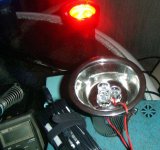
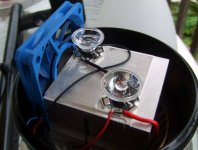
Been exposing a single branch, and a small twin cutting to varying amounts of blue and "royal blue".
Watching the trichomes with my microscope.
Did the same with UVc ~254nm. Mercury vapor/quartz "mineral light" with the Wood's glass filter removed.
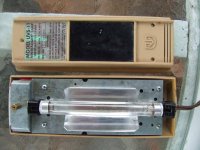
No observable effect at low dosage.
Serious damage at high dosage.
First, it fried off the wax caps containing my hard won resin.
they turned dark, then shriveled, blackened, and dropped.
Longer exposure destroyed leaf tissue on my outdoor test of a Thai crossed Sativa. Killed a whole branch and seared the adjoining branches
Of the pre-fried caps. It did not seem to affect the potency either way, but that is very hard to judge subjectively.
(Affected the hell out of potency when they burned off. )
)
I was hoping that Whazzup actually had chromatography test results that showed a different distribution of resin components caused by UV exposure.
He said he had "proof".
That really got my attention.
Made several attempts to call his hand.
Got one dazzling deflection after another. But. as yet, no proof.
So. lacking proof to the contrary, I'm running on the assumption that my conclusions are correct.
Should this prove to be the case, by not helping, he did help, sort of.
That's just one more reason I'm so tickled to see you here.
We don't always agree, but when you make a statement, you back it up.
You have my respect for that.
And you do it gently. That's a rare skill.
When finding yourself to be in error, you gracefully accept that and discard the bad data without drama.
For that you have my admiration and emulation.
It's nice to be right, but I'd rather get bright.
Egos be damned! I jus' wanna learn.
(didn't say discarding "my facts" was easy, just rewarding.)
So, let me ask you.
Do you have, or know where to find, any real data on UV for Cannabis?
Mahalo and Aloha,
Weeze
Yay! It's KNNA!
Curious thing is I think Whazzup and Weezard mostly agrees with each other, but they look at the topic with different perspectives.
I do mostly agree with Weezard when we talk with the perspective of a small grow for self consumption. In this situation, spaces used are small, usually cold is not an issue, yield requirement may vary from one grow to the next without being a huge problem, and cost may be inexpensive enough compared with other alternatives. In this situation, LEDs works great and I agree complex color mixes are not necessary ( although it dont mean it cant be used to improve results, just that a simple red+blue may work and that blue, white and red definitively works fine).
I only disagree with him about LEDs used. I select LEDs by calculating their efficiency (uE emitted per watt burned) and cost (price per uE emitted). Actually, LedEngines are not good at either of both parameters, although the price may vary depending how and where you source them, of course (so for somebody, LEDEngin may have a better uE/price).
I completely agree Whazzup when I look the topic from a wider perspective. At current prices of LED lighting, in general advantages of the LED lighting not seem enough to compensate the extra cost. It is not that high power LED lamps working as big HID can't be done, but their cost would be too high to be interesting for targeted costumers, so nobody does it. 2-3 years ahead, who knows.
Spot-on! We are in full agreement here!
For the moment, only applications for LED lighting in the greenhouse markets are for situations of low light levels (seedlings and in general, very young and small plants), plant species grown for their leafy material (lettuce), and special situations. One application that may spread well is intracanopy lighting (or just, interlighting), as low temperature, solid LEDs are ideal for doing it and many crops benefits of it (included ours)
But I think main problem is price, and not the possibilities of LED lighting for horticulture in general. And the price problem will disappear on a near future.
Light quality is often noted as a drawback of LED lighting for horticulture. I strongly disagree with this. LED lighting allows to tune the spectrum exactly to fit the exact requirements of each situation. Both when close to sunlight spectrum is required or when a very different one offer advantages. But obviously, it requires to know what spectrum is better on each situation, and that knowledge is what we lack. Each plant specie is different, and into each specie, different cultivars (strains) may react different, too.
An important observation!
In my own, sloppy, way, I'm working on this.
Have obtained a strain that does poorly under fluorescent light.
I'm attempting to "talk color" to it.
I devoted most of my research to this topic, as currently there is more that we dont know about than we know for sure.
For cannabis, we are narrowing down the spectrum that works better, at least for whole grows. Except for the UV range, we know decently what we need to use, and how to vary attending to different situations. Now we need to find optimal spectrums for each stage of development and situations as well as "tricks" allowing to affect some traits by lighting manipulation. I think possibilities of LEDs on this are really huge and severely under researched. Blast of light of narrow wavelengths or combinations of narrow wavelengths for short periods of time have the potential of strongly affect outcomes.
Just an example: could strong blue light blasts affect in a similar way than UV? (I suspect so). Either a pair of hours a day, maybe blasts during three days each 15 days, or at the mid of veg period, then after flowering induction and finally at ripening, etc. Possibilities are almost endless. Or, does a blast of very narrow UVB (290 +-5nm, for example) have a different effect or intensity response that wide UVB or UVB+UVA irradiation?
Real happy to see you here, brah.
Your post is so "spot-on I quoted the whole thing.
Some folks, myself included, have to read it more than once to gain full benefit.
Narrow spectrum "blasts of blue?
I'm on it!


Been exposing a single branch, and a small twin cutting to varying amounts of blue and "royal blue".
Watching the trichomes with my microscope.
Did the same with UVc ~254nm. Mercury vapor/quartz "mineral light" with the Wood's glass filter removed.

No observable effect at low dosage.
Serious damage at high dosage.
First, it fried off the wax caps containing my hard won resin.
they turned dark, then shriveled, blackened, and dropped.
Longer exposure destroyed leaf tissue on my outdoor test of a Thai crossed Sativa. Killed a whole branch and seared the adjoining branches
Of the pre-fried caps. It did not seem to affect the potency either way, but that is very hard to judge subjectively.
(Affected the hell out of potency when they burned off.
I was hoping that Whazzup actually had chromatography test results that showed a different distribution of resin components caused by UV exposure.
He said he had "proof".
That really got my attention.
Made several attempts to call his hand.
Got one dazzling deflection after another. But. as yet, no proof.
So. lacking proof to the contrary, I'm running on the assumption that my conclusions are correct.
Should this prove to be the case, by not helping, he did help, sort of.
That's just one more reason I'm so tickled to see you here.
We don't always agree, but when you make a statement, you back it up.
You have my respect for that.
And you do it gently. That's a rare skill.
When finding yourself to be in error, you gracefully accept that and discard the bad data without drama.
For that you have my admiration and emulation.
It's nice to be right, but I'd rather get bright.
Egos be damned! I jus' wanna learn.
(didn't say discarding "my facts" was easy, just rewarding.)
So, let me ask you.
Do you have, or know where to find, any real data on UV for Cannabis?
Mahalo and Aloha,
Weeze
@weezard: I'm not privileged to share just any research data on a public forum as I explained to you in pm. But rest assured: I will no longer post any "dazling deflections" for you, sorry for even sharing them and bringing them up. Wow, you do know how to appreciate observations and information. You will probably disagree but hey, that's your good right  .
.
Specific UVC radiation has a germicidal use which is even patented by a company called Cleanlight. It is a very successful method to fight powdery mildew. The dosage however is very low, application daily. (and yes I have tested that as well wearing goggles and gloves )
)
@knna: I totally agree that LED's are very useful for steering light as you can completely control the spectrum. LED has put photosynthesis research is a higher gear because it is now very easy to get very small bandwidth light.
Specific UVC radiation has a germicidal use which is even patented by a company called Cleanlight. It is a very successful method to fight powdery mildew. The dosage however is very low, application daily. (and yes I have tested that as well wearing goggles and gloves
@knna: I totally agree that LED's are very useful for steering light as you can completely control the spectrum. LED has put photosynthesis research is a higher gear because it is now very easy to get very small bandwidth light.
knna
Member
Thank for the props, Weez and rives 
We are all working to find what spectrum works better, each one on its own way. And sharing our experiences accelerates the conclusions we can get, or, as least, give insights to other's research.
Along the time Ive spent at the boards, there is some people I learnt to trust in. Whazzup is for sure one of them, and Weezard, another. You both share your personal experiences and do it keeping objectivity. I havent experimented with UV, so I cant offer anything about this topic. But if Whazzup says he has noticed early maturation of trics, elongated tric's stem, I believe him. And when Weez says he didnt noticed any difference when using UV, I believe him aswell. Both are sharing their personal experience, which may be not able to be extrapolated, because they used different methods.
Reading past pages, I see Whazzup says he noticed some physical variation of trics when looking them under the microscope. About cannabinoid content, I understand him to say results are inconclusive yet, that he sees there is some variation as well but that is difficult to say how it translates to the psychotropic effects (correct me if Im wrong, whazzup).
On the other hand, Weez added UV and didnt noticed differences with the same strain grown without UV.
I really dont see a huge difference. Whazzup are not claiming clear differences on psychotropic effect (I read the past pages fast, so maybe Im wrong in this), just he noticed some differences on the physical appearance of trics and suspects there is more apart of it.
So differences between both are smaller than it seems at first look. In order to clear it, it would be required to know how many trials involved the process of getting such conclusions from both, how many strains are involved, what wavebands were used in the experiment, what irradiance was used...
The technical literature on the topic clearly shows that effects of UV is strongly strain and dosage dependent. So it may be very well than you used different UV bands or dosages, or strains used reacted differently.
BTW, Weez, be very careful with that UVC unit. Dangerous stuff for sure: I know one that got blind due it. What you knew using it is known since long time: UVC dont add anything but it have deleterious effects, induce mutations and kill the plants. Its nice to have people here that likes to know for themselves (the way to innovation), but once you checked it, please, dont use more UVC
About the literature on the topic, all Im aware off was linked in the thread "UV light and terpenoids". But, no, there is no conclusive evidence of the effect of UV. Its different to use UVA and UVB, and dosages are very relevant. There is changes for sure, but it is no clear the effect on THC concentration.
Some people using TLC (as whazzup) reports increases on THC content, but not always repeatable. When using TLC, which uses an standard weight of sample, higher THC spot may mean either more THC in the resin or either more resin in the sample. So when UVB results on higher THC, we still dont know if its due to a change in the composition of the resin or just due to a increase in resin production (I believe it is the latter).
What is sure is you dont need UV at all to obtain good quality. Many years of indoor growing under HPS is proof. I believe UVA may enhance terpenes production and UVB, specially when close to 290nm, enhance resin production. But determining the right wavebands to use and the right dosages seems somewhat challenging. But for me, keeping my eyes safe is first, so I dont use UV and Im reluctant to use it still If I have proof of his enhancement effects.
I prefer to study the use of deep blue for the purpose of resin production enhancement, as it seems to work the same way, at the time it provides photons useful for photosynthesis. So Im eager to see your results using those collimated beams blues, Weez. What beam angles you obtain with those lens? What power of LEDs? (that heatsink with fan talks about huge power

We are all working to find what spectrum works better, each one on its own way. And sharing our experiences accelerates the conclusions we can get, or, as least, give insights to other's research.
Along the time Ive spent at the boards, there is some people I learnt to trust in. Whazzup is for sure one of them, and Weezard, another. You both share your personal experiences and do it keeping objectivity. I havent experimented with UV, so I cant offer anything about this topic. But if Whazzup says he has noticed early maturation of trics, elongated tric's stem, I believe him. And when Weez says he didnt noticed any difference when using UV, I believe him aswell. Both are sharing their personal experience, which may be not able to be extrapolated, because they used different methods.
Reading past pages, I see Whazzup says he noticed some physical variation of trics when looking them under the microscope. About cannabinoid content, I understand him to say results are inconclusive yet, that he sees there is some variation as well but that is difficult to say how it translates to the psychotropic effects (correct me if Im wrong, whazzup).
On the other hand, Weez added UV and didnt noticed differences with the same strain grown without UV.
I really dont see a huge difference. Whazzup are not claiming clear differences on psychotropic effect (I read the past pages fast, so maybe Im wrong in this), just he noticed some differences on the physical appearance of trics and suspects there is more apart of it.
So differences between both are smaller than it seems at first look. In order to clear it, it would be required to know how many trials involved the process of getting such conclusions from both, how many strains are involved, what wavebands were used in the experiment, what irradiance was used...
The technical literature on the topic clearly shows that effects of UV is strongly strain and dosage dependent. So it may be very well than you used different UV bands or dosages, or strains used reacted differently.
BTW, Weez, be very careful with that UVC unit. Dangerous stuff for sure: I know one that got blind due it. What you knew using it is known since long time: UVC dont add anything but it have deleterious effects, induce mutations and kill the plants. Its nice to have people here that likes to know for themselves (the way to innovation), but once you checked it, please, dont use more UVC
About the literature on the topic, all Im aware off was linked in the thread "UV light and terpenoids". But, no, there is no conclusive evidence of the effect of UV. Its different to use UVA and UVB, and dosages are very relevant. There is changes for sure, but it is no clear the effect on THC concentration.
Some people using TLC (as whazzup) reports increases on THC content, but not always repeatable. When using TLC, which uses an standard weight of sample, higher THC spot may mean either more THC in the resin or either more resin in the sample. So when UVB results on higher THC, we still dont know if its due to a change in the composition of the resin or just due to a increase in resin production (I believe it is the latter).
What is sure is you dont need UV at all to obtain good quality. Many years of indoor growing under HPS is proof. I believe UVA may enhance terpenes production and UVB, specially when close to 290nm, enhance resin production. But determining the right wavebands to use and the right dosages seems somewhat challenging. But for me, keeping my eyes safe is first, so I dont use UV and Im reluctant to use it still If I have proof of his enhancement effects.
I prefer to study the use of deep blue for the purpose of resin production enhancement, as it seems to work the same way, at the time it provides photons useful for photosynthesis. So Im eager to see your results using those collimated beams blues, Weez. What beam angles you obtain with those lens? What power of LEDs? (that heatsink with fan talks about huge power
Oh go ahead, Dazzle me.
Oh go ahead, Dazzle me.
No feel under appreciated Wazzup, there's more than enough information to be gleaned from what you did not/can not say.
And we may be losing meaning in translation, but you write like English is your first language.
If this is not the case, I'll try to limit my use of idiom and slang.
I'm quite pleased with your offerings, how about you?
Aloha,
Weeze
Oh go ahead, Dazzle me.
@weezard: I'm not privileged to share just any research data on a public forum as I explained to you in pm.
O, K.
But rest assured: I will no longer post any "dazling deflections" for you, sorry for even sharing them and bringing them up. Wow, you do know how to appreciate observations and information. You will probably disagree but hey, that's your good right.
Not at all, brah.
I told you that I enjoyed and appreciated your efforts.
They just didn't address my question.
If you can't share, you can't share.
I'll accept your excuse, and thank you again
Specific UVC radiation has a germicidal use which is even patented by a company called Cleanlight. It is a very successful method to fight powdery mildew. The dosage however is very low, application daily. (and yes I have tested that as well wearing goggles and gloves)
Again.
Not news my brother.
And has nothing to say to the UV/THC connection question.
But Thank you.
@knna: I totally agree that LED's are very useful for steering light as you can completely control the spectrum. LED has put photosynthesis research is a higher gear because it is now very easy to get very small bandwidth light.
No feel under appreciated Wazzup, there's more than enough information to be gleaned from what you did not/can not say.
And we may be losing meaning in translation, but you write like English is your first language.
If this is not the case, I'll try to limit my use of idiom and slang.
I'm quite pleased with your offerings, how about you?

Aloha,
Weeze
"What is sure is you dont need UV at all to obtain good quality. Many years of indoor growing under HPS is proof. I believe UVA may enhance terpenes production and UVB, specially when close to 290nm, enhance resin production. But determining the right wavebands to use and the right dosages seems somewhat challenging. But for me, keeping my eyes safe is first, so I dont use UV and Im reluctant to use it still If I have proof of his enhancement effects.
GMTA
It is a serious hazard, and I did use extreme care.
It's also why I don't wish to continue.
I was using a longer, 30W. 4' germicidal lamp.
Had it mounted on the door to the grow room with an interlock.
It died a few months back, so I used the little rock-light for my outdoor tests.
Only have one working eye.
So, lacking evidence, mine or anyone's, of dramatic improvement, I'm going to retire the UVc while I'm ahead.
I prefer to study the use of deep blue for the purpose of resin production enhancement, as it seems to work the same way, at the time it provides photons useful for photosynthesis. So Im eager to see your results using those collimated beams blues, Weez. What beam angles you obtain with those lens? What power of LEDs? (that heatsink with fan talks about huge power"
And we're back on topic, thanks.
I have 90 and 60 degree lenses on 5W. emitters both blue and royal blue.
Had a UVb incandescent in there for a while, but I was using it as a far red source. (Puts out gobs of far red and very little UVb)
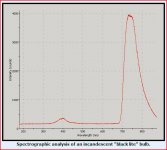
I'm severely limited by my legal plant count so have to make do irradiating one or two colas at a time.
Right now, all my bloomer girls are outside.
September is not a good month here for indoor flowering.
This winter I'll be budding some JH indoor just to play with the lighting again.
I'll look you up when I have good information to share on the spot-lighting.
Real good to see you back here, brother
Aloha,
Weeze
GMTA
It is a serious hazard, and I did use extreme care.
It's also why I don't wish to continue.
I was using a longer, 30W. 4' germicidal lamp.
Had it mounted on the door to the grow room with an interlock.
It died a few months back, so I used the little rock-light for my outdoor tests.
Only have one working eye.
So, lacking evidence, mine or anyone's, of dramatic improvement, I'm going to retire the UVc while I'm ahead.
I prefer to study the use of deep blue for the purpose of resin production enhancement, as it seems to work the same way, at the time it provides photons useful for photosynthesis. So Im eager to see your results using those collimated beams blues, Weez. What beam angles you obtain with those lens? What power of LEDs? (that heatsink with fan talks about huge power"
And we're back on topic, thanks.

I have 90 and 60 degree lenses on 5W. emitters both blue and royal blue.
Had a UVb incandescent in there for a while, but I was using it as a far red source. (Puts out gobs of far red and very little UVb)

I'm severely limited by my legal plant count so have to make do irradiating one or two colas at a time.
Right now, all my bloomer girls are outside.
September is not a good month here for indoor flowering.
This winter I'll be budding some JH indoor just to play with the lighting again.
I'll look you up when I have good information to share on the spot-lighting.
Real good to see you back here, brother

Aloha,
Weeze
hehe just for the record.. my first language is Dutch. I'm very Dutch and live in Holland.
@ knna: There may even be differences in the UVB response with different genetics. The TLC method is quite accurate when you use the correct protocol and depending on the correct tools of course. From the 0,1 gram sample (you would preferably use something better than a hobby scale ) that is dissolved you take only two micro liters for the dot on the plate. Those 2 micro liters are very accurate. But yes, with any testing method it also depends on the sample. Therefore you should be careful to make statements about it before you have been able to repeat that in a double blind test.
) that is dissolved you take only two micro liters for the dot on the plate. Those 2 micro liters are very accurate. But yes, with any testing method it also depends on the sample. Therefore you should be careful to make statements about it before you have been able to repeat that in a double blind test.
The elongated trichome stems and the early and fast development of trichomes can be clearly observed, even without a microscope (although of course we do use one).
The tests we conducted were with Amnesia Haze (a sativa dominant strain) and Anesthesia (a very indica dominant strain). As you can understand it takes months before you can repeat tests, and you always have to do multiple comparisons as every grow, even indoors, can have a lot of differences.
Anyways, back to the spectrum and LEDs
@ knna: There may even be differences in the UVB response with different genetics. The TLC method is quite accurate when you use the correct protocol and depending on the correct tools of course. From the 0,1 gram sample (you would preferably use something better than a hobby scale
The elongated trichome stems and the early and fast development of trichomes can be clearly observed, even without a microscope (although of course we do use one).
The tests we conducted were with Amnesia Haze (a sativa dominant strain) and Anesthesia (a very indica dominant strain). As you can understand it takes months before you can repeat tests, and you always have to do multiple comparisons as every grow, even indoors, can have a lot of differences.
Anyways, back to the spectrum and LEDs
Dear Messers Knna and Weezard,
Just a public thank you for your contributions. In what is often a confusing and volatile subject, youse guys are always the voices of reason and enlightenment.
Just a public thank you for your contributions. In what is often a confusing and volatile subject, youse guys are always the voices of reason and enlightenment.
G
gilgahash
Interesting thread, I cant believe I've missed it this long...
I'm thinking about scaling up my Led pc case (https://www.icmag.com/ic/showthread.php?t=218056) to a closet/ growtent size and have been contemplating building a light using only white Cree XP-G leds of R5 and Q5 bins. Looking at their data sheet http://reefledlights.com/wp-content/uploads/2011/04/xlampxp-g1.pdf The graph of their relative spectral distribution shows nice spikes in both 450 625 range as well as as filling in the green/orange range.
I'm wondering if this the most pragmatic approach or if I'd still be better served by using only targeted Led wavelengths, 455, 625, 660 and cool white? I know my eyes would appreciate the white light, as opposed pink purple eyestrain but that isnt really much of a justification. So what do you guys think?
I'm thinking about scaling up my Led pc case (https://www.icmag.com/ic/showthread.php?t=218056) to a closet/ growtent size and have been contemplating building a light using only white Cree XP-G leds of R5 and Q5 bins. Looking at their data sheet http://reefledlights.com/wp-content/uploads/2011/04/xlampxp-g1.pdf The graph of their relative spectral distribution shows nice spikes in both 450 625 range as well as as filling in the green/orange range.
I'm wondering if this the most pragmatic approach or if I'd still be better served by using only targeted Led wavelengths, 455, 625, 660 and cool white? I know my eyes would appreciate the white light, as opposed pink purple eyestrain but that isnt really much of a justification. So what do you guys think?
knna
Member
Interesting thread, I cant believe I've missed it this long...
I'm thinking about scaling up my Led pc case (https://www.icmag.com/ic/showthread.php?t=218056) to a closet/ growtent size and have been contemplating building a light using only white Cree XP-G leds of R5 and Q5 bins. Looking at their data sheet http://reefledlights.com/wp-content/uploads/2011/04/xlampxp-g1.pdf The graph of their relative spectral distribution shows nice spikes in both 450 625 range as well as as filling in the green/orange range.
I'm wondering if this the most pragmatic approach or if I'd still be better served by using only targeted Led wavelengths, 455, 625, 660 and cool white? I know my eyes would appreciate the white light, as opposed pink purple eyestrain but that isnt really much of a justification. So what do you guys think?
It is perfectly feasible. You can obtain a very complete spectrum using just whites, by combining cool/neutrals with warm whites.
Such solution has some pros and cons:
Pros:
-Easy to do, very straightforward. Simplifies driver design and wiring.
-Spectrum obtained can be very continuous, similar to sunlight (except for a dip in the cyan). This avoid any bad reaction from any strain and promote very healthy growth.
-High percentage of green/yellow compared with typical LED spectrums. This would make this kind of spectrum best suited for using high average light densities. In your case, for use more than the 22W you are using now, and jump to 40W or so, looking for the max production from a small grow area rather than for productivity.
-Very good color rendering, nothing of pinkish tones. You can examine your plants fine without the need of getting them out to see real colors
Cons:
-Higher cost.
-Lower efficiency compared with a setup using blue and reds. Meaning, you need to install more watts to obtain same amount of photons. But right now, that difference is probably smaller than never.
Given you are running a 22W array that seems to be working very well, instead of building a new complete array with whites, you may add more whites to the mix, raise the total power while improving the spectrum for a high light density grow (in such small space, I would consider defoliating when using high light density).
With 9 XP-G running at 700mA, you go to up 40W of total power. As you have a good percentage of red in the array, for this purpose I would use neutral whites about 4000K.
If you want to try the performance of an array of just whites, use cool and warm whites, about half each, but then install some more watts than before in order to get similar amount of light.
G
gilgahash
Well I should start by thanking you KNNA for your wonderful tutorials. It was an immense help to me when I set out to build my light  As you can probably tell I followed your general guidelines for spectrum 15% cool white 15% blue and 70% red and have been very pleased with it results, aside from the eyestrain from the red.
As you can probably tell I followed your general guidelines for spectrum 15% cool white 15% blue and 70% red and have been very pleased with it results, aside from the eyestrain from the red.
I plan on keeping the pc case but supplementing it with a larger case something along the line of 2ft wide x 3ft long x 3ft high. Do you still recommend 39watts/sqft?
Your no doubt right about an all white array being less efficient and less pragmatic. I suppose the simplest solution would be just to keep the reds and whites on separate drivers and just not turn on the reds when tending the plants.
 As you can probably tell I followed your general guidelines for spectrum 15% cool white 15% blue and 70% red and have been very pleased with it results, aside from the eyestrain from the red.
As you can probably tell I followed your general guidelines for spectrum 15% cool white 15% blue and 70% red and have been very pleased with it results, aside from the eyestrain from the red. I plan on keeping the pc case but supplementing it with a larger case something along the line of 2ft wide x 3ft long x 3ft high. Do you still recommend 39watts/sqft?
Your no doubt right about an all white array being less efficient and less pragmatic. I suppose the simplest solution would be just to keep the reds and whites on separate drivers and just not turn on the reds when tending the plants.
Last edited by a moderator:
difficult to say if blue or uv enhance potency..
for one it does, but what bulb did he use? what other factors were at play?
for the next one it doesnt.
like this plant i grew, off to the side of the hps, mostly getting a t5 light 3000k.
ended up a runt with fantastic smoke, smell and taste.
then i ran it under the hps, lot bigger harvest, but taste gone and potency not as good.
while next to it another plant was sticky and smelled wonderful. (different strain)
was it the hps that made it worse? does that strain grow better under less light? or would the other one smell much more wonderful under t5?
difficult to say, also were various factors at play (i moved)
have grown under mh too, didnt notice a increase in thc, though it was glasscovered so hey, maybe its the uv.
fluo certainly has some uv, quite a bit more than hps anyway..
dunno, not really that attracted to having pure uvbulbs in my grow..
i added a bunch of 6500k fluo´s though to the hps, will be interesting to see what happens.
but this is a long time slow hobby and the current social situation makes it trickier.
but its kinda fun so hey
once came across an interesting study, dont have the link though and never bother remembering names and such,..
but it claimed that plants grown under lps, grew better than hps, as long as there was a incandescent or something along to at least give a smattering of the other frequencies.
so, plants were happier with a shitload of orange, than lesser intensities and more of the other spectrums.
kinda interesting though that they needed just a bit of the other colours.
for one it does, but what bulb did he use? what other factors were at play?
for the next one it doesnt.
like this plant i grew, off to the side of the hps, mostly getting a t5 light 3000k.
ended up a runt with fantastic smoke, smell and taste.
then i ran it under the hps, lot bigger harvest, but taste gone and potency not as good.
while next to it another plant was sticky and smelled wonderful. (different strain)
was it the hps that made it worse? does that strain grow better under less light? or would the other one smell much more wonderful under t5?
difficult to say, also were various factors at play (i moved)
have grown under mh too, didnt notice a increase in thc, though it was glasscovered so hey, maybe its the uv.
fluo certainly has some uv, quite a bit more than hps anyway..
dunno, not really that attracted to having pure uvbulbs in my grow..
i added a bunch of 6500k fluo´s though to the hps, will be interesting to see what happens.
but this is a long time slow hobby and the current social situation makes it trickier.
but its kinda fun so hey
once came across an interesting study, dont have the link though and never bother remembering names and such,..
but it claimed that plants grown under lps, grew better than hps, as long as there was a incandescent or something along to at least give a smattering of the other frequencies.
so, plants were happier with a shitload of orange, than lesser intensities and more of the other spectrums.
kinda interesting though that they needed just a bit of the other colours.
one other thing comes to mind.
ever been to the real tropics?
huge leaves everywhere.
well, the sun in the tropics , 15 minutes bareheaded at noon, makes your head practically boil and you run for a shower and some water to drink.
the colors are also much more intense and vibrant. very primal colors.
and the plants love that, plants grown f.e where i live, the high north plants are pathetic in comparison.
add to that that research about the lps. and you cant help but think that the hps is the best we got at the moment (lps is only 200w max) and intensity is what we really need.
though i personally prefer to supplement it with fluo at the moment.
dunno though, these are just my thoughts on the matter and im certainly no where near as knowledgable on this matter as others, particularily knna
ever been to the real tropics?
huge leaves everywhere.
well, the sun in the tropics , 15 minutes bareheaded at noon, makes your head practically boil and you run for a shower and some water to drink.
the colors are also much more intense and vibrant. very primal colors.
and the plants love that, plants grown f.e where i live, the high north plants are pathetic in comparison.
add to that that research about the lps. and you cant help but think that the hps is the best we got at the moment (lps is only 200w max) and intensity is what we really need.
though i personally prefer to supplement it with fluo at the moment.
dunno though, these are just my thoughts on the matter and im certainly no where near as knowledgable on this matter as others, particularily knna
Latest posts
-
-
Problema… il gg prima di partire ovviamente…
- Latest: can'tfindmyway
-
-
Latest posts
-
-
Problema… il gg prima di partire ovviamente…
- Latest: can'tfindmyway
-
-

